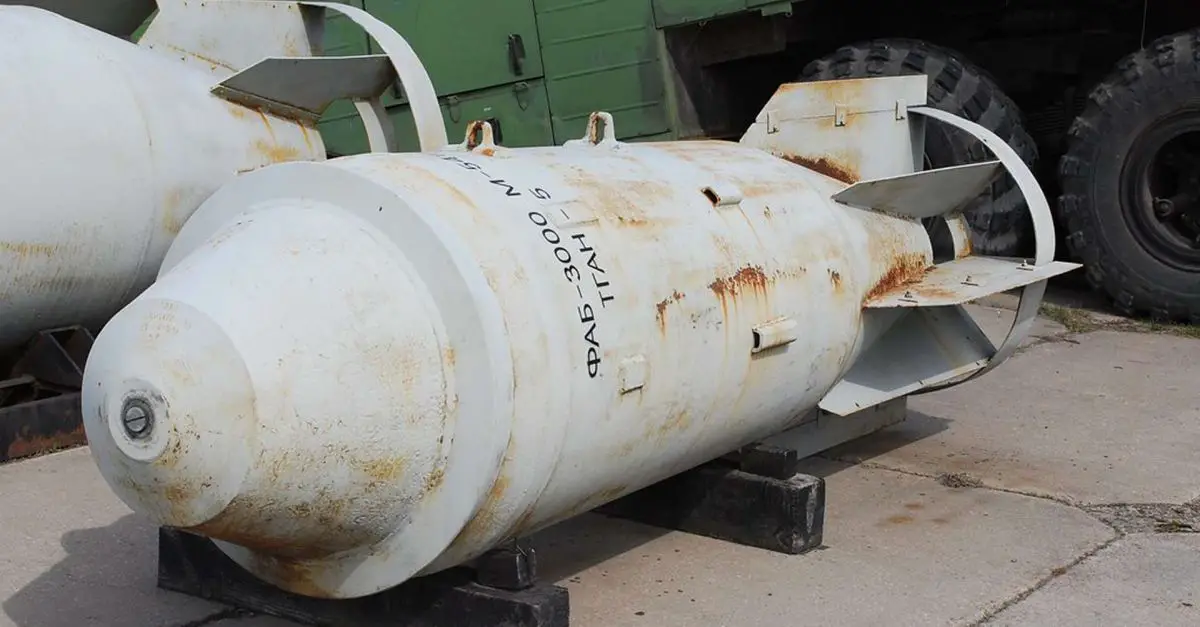Breaking News
Russia develops a new UMPK gliding module to improve the accuracy of the FAB-3000 bomb in Ukraine.
On July 8, 2024, Military Informant reported that a new Unified Gliding and Correction Module (UMPK) is being developed for the Russian FAB-3000 bomb. This initiative aims to enhance the bomb's accuracy and range, addressing the identified inadequacies of the current UMPK version. These inadequacies include the inability to manage the mass-inertial characteristics of the three-ton FAB-3000, resulting in significant misses due to insufficient rudder control for final trajectory adjustments—a problem not observed with the smaller FAB-1500 bomb. Consequently, the new UMPK will feature larger rudders and more powerful drives specifically designed for the FAB-3000.
Follow Army Recognition on Google News at this link

The FAB-3000 bomb weighs approximately 3,000 kg and carries approximately 1,400 kg of TNT. Measuring 3,067 mm in length, this bomb features a maximum penetration capacity of 183 mm, an armor destruction radius of 42 m, and a fragment dispersion radius of 260 m. (Picture source: Russian social media)
Initially, the original developer suggested the need for a specialized UMPK for heavier ordnance. However, due to military urgency and rapid progress in troop equipment deployment, the existing kit was prematurely utilized. Observed shortcomings necessitated a return to the design phase for an improved modification. The anticipated enhancements in the updated UMPK are expected to enable the FAB-3000 to perform with greater precision and effectiveness in future operations in Ukraine.
On March 21, 2024, Russian Defense Minister General of the Army Sergei Shoigu announced the commencement of mass production of the FAB-3000 during a visit to an aviation bomb production facility in the Nizhny Novgorod region. This development marks an expansion in Russia's military capabilities, particularly in the context of the ongoing conflict in Ukraine. Alongside the FAB-3000, the production of the FAB-1500 will be doubled, and there will be an increase in the manufacture of FAB-500 bombs. The newly developed FAB-3000M-54, designed for strategic use by the Tu-22M3 Heavy Bombers, highlights its role in current conflict dynamics.
The FAB-3000 bomb weighs approximately 3,000 kg and carries approximately 1,400 kg of TNT. Measuring 3,067 mm in length, this bomb features a maximum penetration capacity of 183 mm, an armor destruction radius of 42 m, and a fragment dispersion radius of 260 m. Designed for strategic bombing, the bomb can penetrate reinforced structures before detonating to cause direct, significant damage to large, fortified targets such as bunkers, bridges, and industrial facilities, due to its blast and shockwave. Typically deployed by heavy bombers due to its significant weight and size, the fragment dispersion radius of the FAB-3000 denotes the wider area over which bomb fragments scatter, posing lethal risks to personnel and causing secondary damage. The deployment of such munitions raises concerns over their humanitarian and infrastructural impact, especially in densely populated or strategically vital areas as Russia intensified its aerial bombardment campaigns.

The UMPK gliding module can be mounted on various Russian bombs, such as the FAB-1500-M54. (Picture source: Russian MoD)
The UMPK is a Russian-developed kit that converts traditional unguided bombs into precision-guided munitions by attaching a set of wings and a guidance system. This allows the bomb to glide towards its target with improved accuracy. The UMPK kit includes foldable wings and tail fins, enabling the bomb to glide over long distances. It incorporates a satellite navigation system, typically relying on GLONASS, to guide the bomb accurately to its target. Designed to be compatible with various types of bombs, primarily those from the Soviet era, the UMPK extends the range of bombs, allowing them to glide up to 70 kilometers from the release point. This enables aircraft to drop bombs without entering heavily defended airspace.
Since their introduction, UMPK-equipped bombs have been increasingly used in the ongoing conflict in Ukraine. These bombs are relatively inexpensive to produce, costing less than $20,000 each, making them a cost-effective solution compared to more sophisticated precision-guided munitions like cruise missiles. By retrofitting existing bombs, Russia can use its stockpiles of Soviet-era munitions, extending their utility and reducing waste.
Despite their effectiveness, operational issues such as occasional failure to detonate and malfunctions have been observed. Ukrainian forces face significant challenges in countering these bombs due to their extended range and precision. Enhanced air defenses and Western-supplied systems like the Patriot have played a role in intercepting the delivery aircraft, although their limited numbers often mean they are reserved for protecting key areas.

The UMPK gliding module is typically mounted after the bomb has been attached to the plane, such as this FAB-500-M62 on a Su-34 jet. (Picture source: Twitter/Andrei_bt)


























